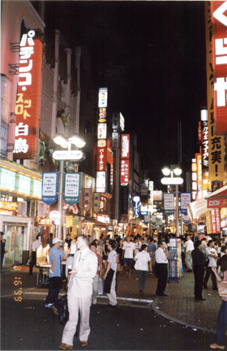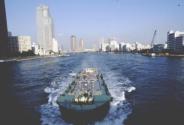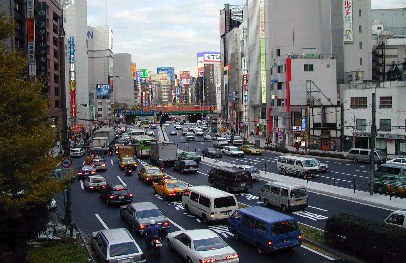|
JAPAN
The
Japanese archipelago has long been a favourite of more adventurous
travellers, and with high-tech Tokyo and vibrant Osaka increasingly
popular choices for long-haul stopovers, and Japanese culture more
fashionable than ever, there has never been a better time to explore
this multifaceted country.
Japan is one of
the safest countries in the world, and there's no need to worry about
the language barrier - the Japanese are unfailingly friendly so help is
always at hand. Whether you choose to climb Mount Fuji or relax at
volcanic hot spring resorts, delight in traditional performing arts or
lose yourself in high-tech wonderland, Japan is a truly unforgettable
destination
Tokyo
Tokyo,
symbol of the Japanese success story, is a sprawling megalopolis on the
Pacific coast of Honshu, the largest island of the Japanese archipelago.
In 1590, the city was founded as Edo, the capital of the shoguns,
the succession of hereditary absolute rulers of Japan and commander of
the Japanese army. Edo boasted its own vibrant culture, the celebrated
'floating world' of pleasure quarters, theatres and cherry blossoms,
immortalised in the Japanese woodblock prints of the time. Following the
fall of the shoguns in 1867 (and the restoration of the power of the
Emperor), the city was renamed Tokyo, the Eastern Capital, heralding its
rebirth as a dynamic modern city and the showpiece of a rapidly
modernising country. Despite the catastrophic 1923 earthquake and near
obliteration during World War II, Tokyo was able to rise from the ashes
to host the 1964 Olympics, and went on to preside over the Japanese
economic miracle.
That this bewildering amalgamation of districts
and neighbourhoods is able to function as a coherent whole is largely
due to the extraordinarily efficient network of rail and underground
lines that crisscross and encircle the city. These are Tokyo's arteries,
transporting legions of businesspeople, office workers and students from
the suburbs and depositing them in vast stations. Two million people a
day pass through Shinjuku Station alone. The towering business districts
swarm with soberly dressed corporate warriors and the demure young
secretaries known as 'office flowers'. The architectural anarchy and
sheer crush of humanity assaults the senses. Amid the frenzy of
consumerism, brash electronics outlets are crammed next to refined
upscale boutiques and hordes of giggling schoolgirls swoon over pop
idols and the latest fashions in glitzy emporiums.
Downtown, old neighbourhoods cluster around
antiquated shopping arcades and the clatter of the temple bell echoes
across the rooftops. Here, the rhythms of the seasons are still
observed. Tokyoites flock to ring in the New Year at the venerable
Shinto shrines and springtime brings a flurry of flower-viewing parties
and picnics under the cherry blossoms. Rowdy, traditional festivals
punctuate the humid summers and the spirit of the old Edo also survives
in the neon-bathed entertainment districts: modern-day 'floating worlds'
of karaoke and cinemas, shot bars and bathhouses. Traditional kabuki
theatre thrives alongside opera, ballet and symphonic performances, and
Tokyoites are passionate about both sumo and baseball. Another
obsession, food, is well catered for in this city of 60,000 restaurants
and the world's largest fish market. From bowls of steaming ramen
noodles to delicate slices of sashimi, chefs compete to offer the
freshest produce, and presentation is elevated to an art form.
The focus of Japan's highly centralised
government, business and financial institutions, Tokyo has been hard hit
by the recession, bank collapses and scandals of the 1990s. Many
certainties of the past have been swept away, however, despite
widespread trepidation about the transitions ahead, the city and its
people remain prosperous and forward-looking.
Japan's capital and centre of business and finance, Tokyo offers a
surprising blend of futuristic cityscapes, historic sights and cultural
entertainments. A vast conglomeration of districts, each boasts its own
characteristic attractions. The Ginza
is one of Asia's shopping paradises. Prices are high but the selection
and presentation are superb. Nearby is the Kabukiza
Theatre and the Imperial
Palace (closed to the public) with its impressive moat and East Garden (Higashi Gyoen). Tokyo
Tower affords excellent views of the bay and the space age
architecture on Rainbow Town (O-daiba), a reclaimed island. Early risers will enjoy touring the
massive waterfront Tsukiji Fish
Market. Roppongi and Akasaka, playgrounds for the nearby banking and governmental
districts, offer vibrant nightlife of every kind, from geisha teahouses
to discos. For youth culture, fashion and trendy dining, Shibuya and Harajuku are
the places to see and be seen, while the forested oasis of the Meiji
Shrine offers respite from the crowds. West
Shinjuku is Tokyo's high-rise metropolis with its 'Gothem City'
skyscrapers and plazas. To the east, Shinjuku's
bustling shopping and neon-lit nightlife districts contrast strongly
with the calm beauty of the neighbouring Shinjuku
Gyoen National Garden. For a taste of 'Old Tokyo', the downtown Shitamachi area is the place to head for, particularly in the summer
when three enormous festivals attract vast crowds of revellers and
spectators. The Asakusa-Kannon
Temple is the area's main tourist draw, a vibrant Buddhist complex
approached via a colourful shopping lane. Across the river, Ryogoku
is the location of the excellent Edo-Tokyo
Museum and the renowned National
Sumo Stadium. Ueno is
famous for its large park containing several important art museums and
cultural venues. Cheap eats and bargains galore are to be found at
raucous Ameyoko Market
.
Narita
Excursions: Narita, location
of Tokyo International Airport,
is an attractive old town with a large and impressive pilgrimage temple,
Narita-san. Nearby Tokyo Disneyland is a major year-round attraction for Japanese and
foreigners alike. Two hours north of Tokyo in Nikko, the extraordinary Toshogu
Shrine complex is situated, where the mausoleum of the founder of
Japan's Tokugawa Shogunate. The surrounding Nikko
National Park offers mountain hot spring resorts and opportunities
for hiking, fishing and boating. Pottery fans will enjoy the rural kiln
town of Mashiko. The coastal
town of Kamakura, one hour
south of Tokyo, was the seat of Japan's medieval feudal government and
abounds in historic sights. Highlights include the giant bronze Great
Buddha, colourful Hachimangu
Shrine and picturesque Enoshima
Island. The international port city of Yokohama,
30 minutes from Tokyo, has a vibrant Chinatown,
harbour district and historic Sankei-en
Garden. Japan's highest mountain, Mount
Fuji, may be climbed during the high summer. Located one hour 30
minutes from Tokyo is Fuji-Hakone-Izu
National Park, a recreational paradise offering hot spring resorts,
golf courses and facilities for fishing, camping, hiking, swimming and
boating. At Hakone, cable
cars carry visitors over volcanic landscapes of boiling mud, sightseeing
boats ply scenic Lake Ashi
and there is an Open Air Sculpture
Museum, a Porsche Museum
and several sights of historical interest.
|
|






|





